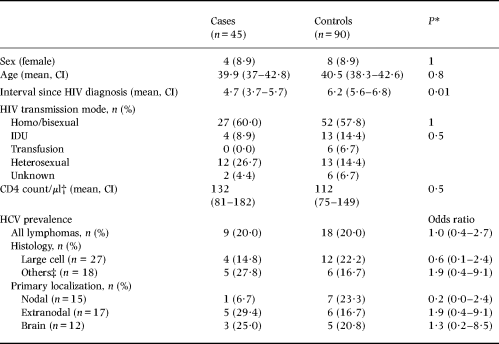LACK OF ASSOCIATION BETWEEN HCV INFECTION AND HIV-RELATED LYMPHOMA
HIV-related lymphomas are known to be associated with viruses such as Epstein-Barr virus and Kaposi sarcoma herpes virus (KSHV) (Nador et al, 1996). Recently, hepatitis C virus (HCV) has been found to be associated with B-cell non-Hodgkin lymphomas (NHL) (Ferri et al, 1994; Silvestri & Baccarani, 1998; Zuckerman et al, 1997). We studied the association between HCV and lymphoma in HIV-infected individuals.
A retrospective population-based case–control study was performed identifying all patients with B-cell lymphoma among HIV-infection patients followed in the hospital of the Pasteur Institute in Paris (France) from July 1993 to February 1998. 45 patients with lymphoma were included and compared with 90 control patients with HIV infection but no lymphoma. The controls were matched with patients with lymphoma for sex and age and within 6 months of hospitalization. HIV and hepatitis C antibodies were performed by standard methods (Pasteur Elisa or Axym Abbot, HCV PCR Monitor Roche). We detected no significant difference in the general characteristics of cases and controls (Table I) except for the interval between first HIV-positive test and hospitalization (4.7 years for cases and 6.2 years for controls, P = 0.01). The proportion of women was 8.9%. The mean age of cases was 39.9 years (24–68 years). The mean CD4 count was 132/μl among cases (4–629/μl), 112/μl among controls (1–1067/μl, P = 0.5). Presumed transmission modes of HIV did not differ significantly between cases and controls. The proportion of patients with clinical Kaposi sarcoma did not differ significantly between cases and controls (11.1% v 22.2%, P = 0.3). Anti-retroviral treatments at the time of hospitalization did not differ between cases and controls (data not shown).

Among the patients with lymphomas, 27 (60%) had large cell lymphomas (DLCL), nine had Burkitt lymphomas, three had Hodgkin lymphomas, four others had B-cell malignancies (two immunoblastic, one plasmocytic and one B marginal) and two were not classified. The primary localizations were nodal (33%), extranodal (40%) and brain (27%). No significant association was found between histology or localization and HIV transmission mode, Kaposi sarcoma or anti-retroviral treatment.
HCV infection among the cases and controls was diagnosed by detection of anti-HCV antibody in 26 patients and in one case, despite negative serology, by RNA HCV PCR. HCV-infected patients were significantly younger than non-HCV infected patients (36.1 v 41.4 years, P < 0.01). Interval between first HIV-positive test and hospitalization and mean CD4 count did not differ between HCV-infected patients and other patients. Proportion of HCV-infected individuals was much higher among intravenous drug users (95%) than among homo/bisexuals (5%, P < 0.01). Evidence of HCV infection was similar in cases and controls (20%). No significant relation was found between histology or localization and HCV infection (Table I).
This case–control study demonstrated a very low probability of association between HCV and HIV-related lymphoma. Because of the small number of cases of each subtype of HIV-related lymphomas, our study would have detected only a very large association with subtypes of lymphomas and HCV infection. Two previous case–control studies found no association between HIV-related lymphoma and HCV (A. Levine et al, unpublished observations; Tirelli et al, 1997), when controls were matched for transmission mode. However, patients were not matched for this factor in our study. The distribution of our case population by histology and localization is representative of HIV-related lymphomas. However, an earlier infection by HIV is not associated with HCV and therefore should not be a bias in our study. Our results suggest that HCV is not an aetiological factor of lymphoma in HIV-infected persons.




